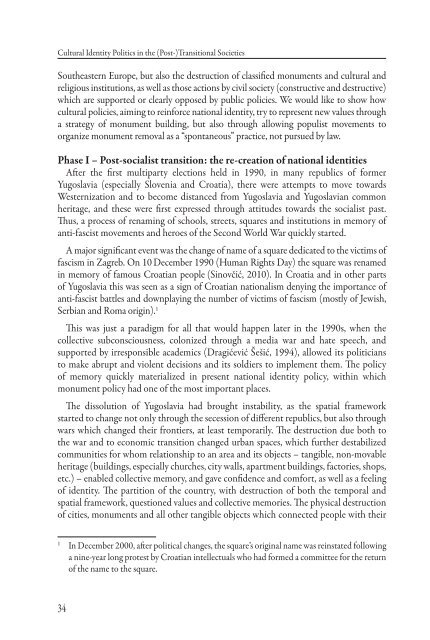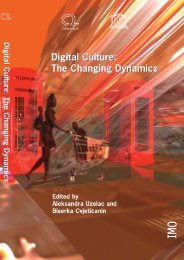free download in pdf format - Culturelink Network
free download in pdf format - Culturelink Network
free download in pdf format - Culturelink Network
You also want an ePaper? Increase the reach of your titles
YUMPU automatically turns print PDFs into web optimized ePapers that Google loves.
Cultural Identity Politics <strong>in</strong> the (Post-)Transitional Societies<br />
Southeastern Europe, but also the destruction of classifi ed monuments and cultural and<br />
religious <strong>in</strong>stitutions, as well as those actions by civil society (constructive and destructive)<br />
which are supported or clearly opposed by public policies. We would like to show how<br />
cultural policies, aim<strong>in</strong>g to re<strong>in</strong>force national identity, try to represent new values through<br />
a strategy of monument build<strong>in</strong>g, but also through allow<strong>in</strong>g populist movements to<br />
organize monument removal as a “spon taneous” practice, not pursued by law.<br />
Phase I – Post-socialist transition: the re-creation of national identities<br />
Aft er the fi rst multiparty elections held <strong>in</strong> 1990, <strong>in</strong> many republics of former<br />
Yugoslavia (especially Slovenia and Croatia), there were attempts to move towards<br />
Westernization and to become distanced from Yugoslavia and Yugoslavian common<br />
heritage, and these were fi rst expressed through attitudes towards the socialist past.<br />
Th us, a process of renam<strong>in</strong>g of schools, streets, squares and <strong>in</strong>stitutions <strong>in</strong> memory of<br />
anti-fascist movements and heroes of the Second World War quickly started.<br />
A major signifi cant event was the change of name of a square dedicated to the victims of<br />
fascism <strong>in</strong> Zagreb. On 10 December 1990 (Human Rights Day) the square was renamed<br />
<strong>in</strong> memory of famous Croatian people (S<strong>in</strong>ovčić, 2010). In Croatia and <strong>in</strong> other parts<br />
of Yugoslavia this was seen as a sign of Croatian nationalism deny<strong>in</strong>g the importance of<br />
anti-fascist battles and downplay<strong>in</strong>g the number of victims of fascism (mostly of Jewish,<br />
Serbian and Roma orig<strong>in</strong>). 1<br />
Th is was just a paradigm for all that would happen later <strong>in</strong> the 1990s, when the<br />
collective subconsciousness, colonized through a media war and hate speech, and<br />
supported by irresponsible academics (Dragićević Šešić, 1994), allowed its politicians<br />
to make abrupt and violent decisions and its soldiers to implement them. Th e policy<br />
of memory quickly materialized <strong>in</strong> present national identity policy, with<strong>in</strong> which<br />
monument policy had one of the most important places.<br />
Th e dissolution of Yugoslavia had brought <strong>in</strong>stability, as the spatial framework<br />
started to change not only through the secession of diff erent republics, but also through<br />
wars which changed their frontiers, at least temporarily. Th e destruction due both to<br />
the war and to economic transition changed urban spaces, which further destabilized<br />
communities for whom relationship to an area and its objects – tangible, non-movable<br />
heritage (build<strong>in</strong>gs, especially churches, city walls, apartment build<strong>in</strong>gs, factories, shops,<br />
etc.) – enabled collective memory, and gave confi dence and comfort, as well as a feel<strong>in</strong>g<br />
of identity. Th e partition of the country, with destruction of both the temporal and<br />
spatial framework, questioned values and collective memories. Th e physical destruction<br />
of cities, monuments and all other tangible objects which connected people with their<br />
1 In December 2000, aft er political changes, the square’s orig<strong>in</strong>al name was re<strong>in</strong>stated follow<strong>in</strong>g<br />
a n<strong>in</strong>e-year long protest by Croatian <strong>in</strong>tellectuals who had formed a committee for the return<br />
of the name to the square.<br />
34



